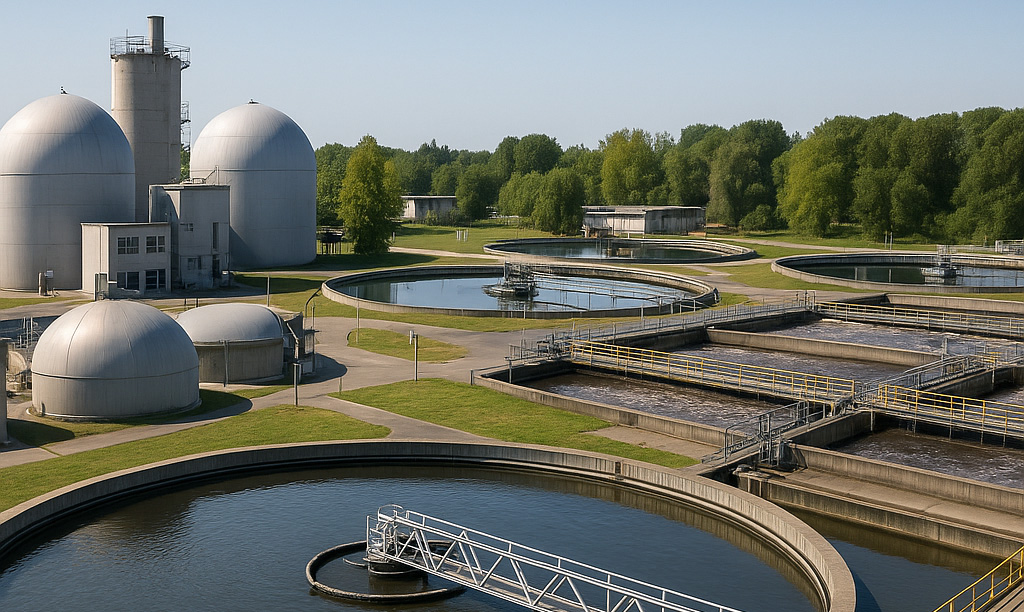TECHNOLOGY FOR CAPTURING BIOGENIC COMPOUNDS AFTER MUNICIPAL WASTEWATER TREATMENT PLANTS
Key advantages of the developed technology:
- carrying out the process without the need for wastewater storage and aeration,
- simplification of the polishing process,
- cost reduction while still meeting increasingly stringent standards,
- reuse of grey water,
- low installation maintenance costs.

THREATS ASSOCIATED WITH EXCESS NITROGEN AND PHOSPHORUS COMPOUNDS
Surface waters receive pollutants discharged with wastewater, including nitrogen and phosphorus compounds, whose accumulation poses many threats.
I will mention three main ones:
1. Intensification of eutrophication processes,
Elevated concentrations of nitrogen and phosphorus initiate eutrophication, i.e. the enrichment of water bodies with nutrients. The consequence of this process is accelerated growth of plants, especially algae and plankton, and a dangerous oxygen deficit for aquatic organisms. This results in their die-off, which in turn leads to the formation of toxic substances such as ammonia, methane, and hydrogen sulfide. Prolonged eutrophication contributes to the aging of water reservoirs, which gradually become shallower and transform into peat bogs due to the accumulation of sediments containing the remains of decaying flora and fauna.
2. Toxic impact on aquatic biocenosis,
The toxic impact on aquatic life is mainly associated with the presence of ammonia, which originates not only from the decomposition of organic matter. Its source is also ammonium ions, which in an alkaline environment convert into free ammonia.
3. Harmful effects on humans,
Excessive amounts of nitrogen-containing compounds are harmful to humans. The concentration of nitrites (NO₂⁻) should not exceed 1 mg/dm³. Consuming larger amounts of nitrites can cause a disease that impairs hemoglobin’s ability to transport oxygen, especially in children and infants. It is also widely believed that nitrates are linked to the occurrence of cancer.
The problem of biogenic substances in treated wastewater is so serious that it is subject to legal regulation. The maximum permissible concentrations of pollutants in wastewater discharged into the environment, including total phosphorus and various forms of nitrogen, are regulated by appropriate legislation. As a result of intensified economic development, wastewater discharges, and agricultural fertilization, this phenomenon has become the most serious threat to our lakes.
WASTEWATER POLISHING SYSTEM BASED ON ION-EXCHANGE UNITS
I am pleased to introduce Blue Tech Water Sp. z o.o. and propose a solution to the problem of municipal wastewater polishing. We specialize in liquid treatment and water purification. We use ion-exchange techniques that allow for selective liquid treatment.
The containerized station is designed to polish municipal wastewater after the treatment process in a biological wastewater treatment plant. This technology surpasses all biological methods in terms of efficiency and is resistant to changing operating conditions, including fluctuations in temperature, pH, and oxygenation. I would like to emphasize that our technology achieves the desired effect by treating wastewater continuously—without storage, mixing, or adding hazardous preparations and solutions. The process is simple, safe, and economical. The units operate automatically and are maintenance-free. The system is equipped with a suction pump and a discharge system for polished wastewater.
The system includes:
– mechanical filtration,
– ion-exchange filtration,
– disinfection (optional).
Laboratory-scale tests have confirmed the system’s effectiveness. The reduction of phosphates and nitrates reached about 98%. This result led to the construction of a model, which was tested at a municipal wastewater treatment plant in Halinów.
After adaptation for continuous operation, the model was installed at the Warsaw Zoological Garden in the fish breeding section, where it operated continuously for almost a year.
The system’s effectiveness exceeded expectations, as the modified system captures not only biogenic compounds but also organic acids, preventing secondary water degradation and pH reduction, while simultaneously inhibiting the formation and growth of algae.
All wastewater treatment plants discharging into lakes and those serving more than 2,000 PE (population equivalent) are obliged to reduce biogenic compounds in municipal wastewater.
Treatment plants are divided into three size groups:
– Group I – 2,000–15,000 PE,
– Group II – 15,000–100,000 PE,
– Group III – over 100,000 PE.
The prototype covers the first group (in Poland there are about 1,000 treatment plants of this size) and is dedicated to plants up to 5,000 PE, which represents 40% of the plants in this group.
It should be noted that these are old plants built using less modern solutions, often awaiting modernization, as they are unable to meet the increasingly stringent requirements for treated wastewater parameters.
The issue of reducing biogenic compounds remains the subject of scientific conferences, as this problem has not yet been fully resolved.



